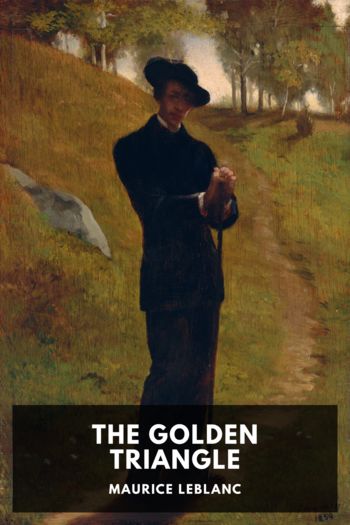The Golden Triangle by Maurice Leblanc (top rated books of all time TXT) 📕

- Author: Maurice Leblanc
Book online «The Golden Triangle by Maurice Leblanc (top rated books of all time TXT) 📕». Author Maurice Leblanc
By Maurice Leblanc.
Translated by Alexander Teixeira de Mattos.
Table of Contents Titlepage Imprint I: Coralie II: Right Hand and Left Leg III: The Rusty Key IV: Before the Flames V: Husband and Wife VI: Nineteen Minutes Past Seven VII: Twenty-Three Minutes Past Twelve VIII: Essarès Bey’s Work IX: Patrice and Coralie X: The Red Cord XI: On the Brink XII: In the Abyss XIII: The Nails in the Coffin XIV: A Strange Character XV: The Belle Hélène XVI: The Fourth Act XVII: Siméon Gives Battle XVIII: Siméon’s Last Victim XIX: Fiat Lux! Endnotes Colophon Uncopyright ImprintThis ebook is the product of many hours of hard work by volunteers for Standard Ebooks, and builds on the hard work of other literature lovers made possible by the public domain.
This particular ebook is based on a transcription produced for Project Gutenberg and on digital scans available at the HathiTrust Digital Library.
The writing and artwork within are believed to be in the U.S. public domain, and Standard Ebooks releases this ebook edition under the terms in the CC0 1.0 Universal Public Domain Dedication. For full license information, see the Uncopyright at the end of this ebook.
Standard Ebooks is a volunteer-driven project that produces ebook editions of public domain literature using modern typography, technology, and editorial standards, and distributes them free of cost. You can download this and other ebooks carefully produced for true book lovers at standardebooks.org.
I CoralieIt was close upon half-past six and the evening shadows were growing denser when two soldiers reached the little space, planted with trees, opposite the Musée Galliéra, where the Rue de Chaillot and the Rue Pierre-Charron meet. One wore an infantryman’s sky-blue greatcoat; the other, a Senegalese, those clothes of undyed wool, with baggy breeches and a belted jacket, in which the Zouaves and the native African troops have been dressed since the war. One of them had lost his right leg, the other his left arm.
They walked round the open space, in the center of which stands a fine group of Silenus figures, and stopped. The infantryman threw away his cigarette. The Senegalese picked it up, took a few quick puffs at it, put it out by squeezing it between his forefinger and thumb and stuffed it into his pocket. All this without a word.
Almost at the same time two more soldiers came out of the Rue Galliéra. It would have been impossible to say to what branch they belonged, for their military attire was composed of the most incongruous civilian garments. However, one of them sported a Zouave’s chechia, the other an artilleryman’s képi. The first walked on crutches, the other on two sticks. These two kept near the newspaper-kiosk which stands at the edge of the pavement.
Three others came singly by the Rue Pierre-Charron, the Rue Brignoles and the Rue de Chaillot: a one-armed rifleman, a limping sapper and a marine with a hip that looked as if it was twisted. Each of them made straight for a tree and leant against it.
Not a word was uttered among them. None of the seven crippled soldiers seemed to know his companions or to trouble about or even perceive their presence. They stood behind their trees or behind the kiosk or behind the group of Silenus figures without stirring. And the few wayfarers who, on that evening of the 3rd of April, 1915, crossed this unfrequented square, which received hardly any light from the shrouded street-lamps, did not slacken pace to observe the men’s motionless outlines.
A clock struck half-past six. At that moment the door of one of the houses overlooking the square opened. A man came out, closed the door behind him, crossed the Rue de Chaillot and walked round the open space in front of the museum. It was an officer in khaki. Under his red forage-cap, with its three lines of gold braid, his head was wrapped in a wide linen bandage, which hid his forehead and neck. He was tall and very slenderly built. His right leg ended in a wooden stump with a rubber foot to it. He leant on a stick.
Leaving the square, he stepped into the roadway of the Rue Pierre-Charron. Here he turned and gave a leisurely look to his surroundings on every side. This minute inspection brought him to one of the trees facing the museum. With the tip of his cane he gently tapped a protruding stomach. The stomach pulled itself in.
The officer moved off again. This time he went definitely down the Rue Pierre-Charron towards the center of Paris. He thus came to the Avenue des Champs-Élysées, which he went up, taking the left pavement.
Two hundred yards further on was a large house, which had been transformed, as a flag proclaimed, into a hospital. The officer took up his position at some distance, so as not to be seen by those leaving, and waited.
It struck a quarter to seven and seven o’clock. A few more minutes passed. Five persons came out of the house, followed by two more. At last a lady appeared in the hall, a nurse wearing a wide blue cloak marked with the Red Cross.
“Here she comes,” said the officer.
She took the road by which he had arrived and turned down the Rue Pierre-Charron, keeping to the right-hand pavement and thus making for the space where the street meets the Rue de Chaillot. Her walk was light, her step easy and well-balanced. The wind, buffeting against her as she moved quickly on her way, swelled out the long blue veil floating around her shoulders. Notwithstanding the width of the cloak, the rhythmical swing of her body and the youthfulness of her figure were revealed. The officer





Comments (0)